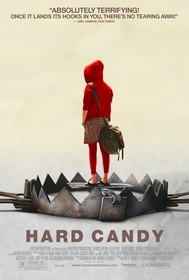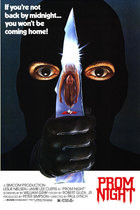Our editor-in-chief Nate Yapp is proud to have contributed to the new book Hidden Horror: A Celebration of 101 Underrated and Overlooked Fright Flicks, edited by Aaron Christensen. Another contributors include Anthony Timpone, B.J. Colangelo, Dave Alexander, Classic-Horror.com's own Robert C. Ring and John W. Bowen. Pick up a copy today from Amazon.com!
Hard Candy (2005)
Amid grief-inducing torture films like Hostel and Wolf Creek, and, on a much different part of the map, NBC’s ever-so-entertaining child predator stings on To Catch a Predator came the release of Hard Candy, a feel-good torture flick for the whole family, one you don’t have to feel bad about watching because its sadism is worked upon that member of society we all despise the most — the pedophile — and because its violence is mostly off-screen. An interesting premise. It’s just too bad the movie itself couldn’t follow suit.
Hard Candy is actually more thriller than horror. Hayley Stark, a boyish teenage girl has met a professional photographer, Jeff Kohlver, online. The movie begins with them agreeing to meet for coffee. After a few minutes of conversation, Hayley agrees to come back to Jeff’s house. After some vodka and a little more talk, Hayley convinces Jeff to take some pictures of her. Jeff pulls out his camera but then passes out. He wakes up in an unexpected way: tied to a chair, and we learn that he was poisoned. Of course Jeff had motives that he wasn’t letting Hayley in on, but she, as we learn, has some motives of her own. From here, we’re treated to a progression of drama, pain, and implausibility that spans the rest of the movie.
This film has two clear objectives: to create realistic dialogue and to open debate. The former is somehow overdone, and the latter never really stood a chance. From the moment man and girl meet, they both (though especially Jeff) say exactly what we would expect them to say. She “innocently” talks about how good her cake is, he “caringly” warns her to watch out for creepy men, and so on. Once he is tied-down, he continues to say exactly what we would expect someone in his place to say. The problem is that all of this is too expected. Director David Slade and writer Brian Nelson pull every single line out of the hat just to make us say, “Ooh, that is just what he would say,” over and over. Perhaps Jeff’s account of an instance of childhood abuse (thankfully placed as a possible reason, not an excuse, for his pedophilia) was an attempt at unexpected dialogue, but that too is just what our culture has been taught to expect — empathize with the bad guy — so it is just another cliché. Also due to the twist is Hayley’s freedom to talk about what she thinks, how she feels, and what she’s going to do to Jeff. We are meant to be surprised by her calm tone throughout the unveiling of hidden motives and nasty tricks, but she constantly speaks so self-consciously matter-of-fact that it quickly becomes obnoxious. The writers would have done much better to show some restraint.
Then we have the film’s attempt at controversy: victimized child terrorizes adult predator. Sure, we don’t feel particularly bad for the guy. Sure, we understand the girl is (only?) trying to protect society. But, is this behavior morally acceptable? Is this something we are willing to approve of? Of course, people’s opinions will differ here. However, the controversy is not attained because everybody already has an opinion. Supporters of the film will respond, “But now the situation is brought to the viewer’s immediate visual attention,” but that is just a cop-out. Such stances should be based on reason, not the guilt or pleasure we find in watching one stance being carried out on screen.
Finally, there is the cinematography, which I am a little confused about. The set for this film (it takes place mostly within Jeff’s house) is beautiful. Having a photographer as a main character means you can decorate his house as artistically as you want, and what we have is some great modern décor. Solid wall colors, too, are used in stark contrast (or almost zero contrast in one interesting room) with the characters’ faces, but the camera unfortunately has an aversion to giving us more than shots of these faces. Every once in a while we get a look at what’s around them, but for the vast majority of the film, you are looking at a face with some background. Even when the camera is brave enough to pull back, it is usually only just as much as it has to, and it is usually because it is necessary for us to see something important to the plot. I can understand that the filmmakers probably did this so that we would focus more on the dialogue, but it gets to be pretty annoying and makes for a visually boring film. It makes me wonder why film is this story’s medium at all.
It is unfortunate that Hard Candy was not executed well because, as I said, it really does have an interesting premise, one that could have been rewarding. Roger Ebert has pointed out, for example, that despite her punishing Jeff for his sexual iniquity, there is something very sexual about Hayley’s tying him up and terrorizing him as she does, especially considering the pleasure she seems to derive from it. There are good things in this movie, but the movie is mediocre. Let’s not forget, though, that this is Slade’s first major shot at directing. Let’s give him another chance to see what he can do.








